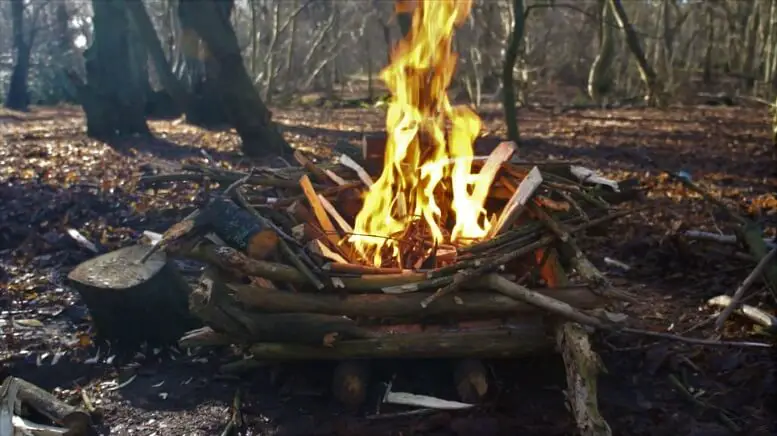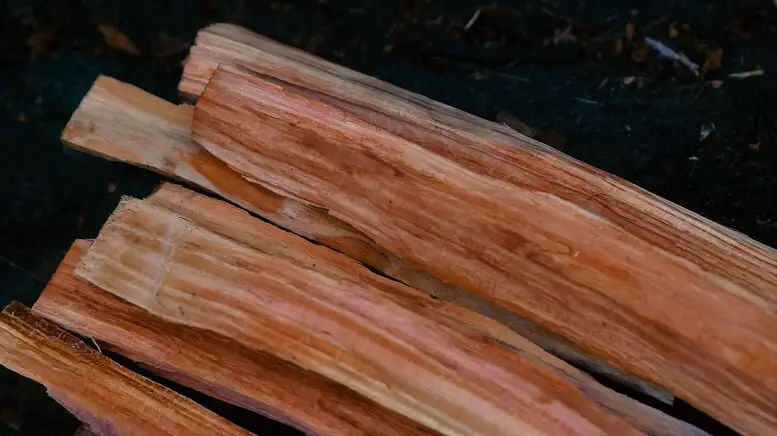Note: This article may contain affiliate links, which means if you make a purchase following our links won’t cost you extra, but we may earn a commission. Learn more
When it comes to starting a fire, there are a lot of factors that come into play. The type of wood you use, the weather conditions, and even the time of day can all affect whether or not your fire will stay lit. But what about the moisture content of the wood? Is it ok to start a fire with wet wood?
The answer is – Shouldn’t! Starting a fire with wet wood is the only advantage – you get heat, all the rest are disadvantages. First, it is important to know that wet wood will not catch fire as easily as dry wood. This is because the moisture in the wood will prevent the wood from igniting as easily. Also, wet wood produces a lot of smoke, which is a health issue.
Burning wet firewood in a fireplace or stove can also cause creosote buildup. If you’ve ever looked up at a smokestack, you may have noticed a black, sooty substance clinging to the sides. That’s creosote, and it’s the result of incomplete burning of fuel.
When wood is burned, the smoke that’s produced contains a lot of volatile compounds, including tar and other hydrocarbons. If those compounds don’t get fully burned off, they can condense on the inside of the chimney or stovepipe and create a sticky, flammable mess.
Wet wood also doesn’t produce as much heat as dry wood. The water content of wood is important not just for safety reasons, but also for practical ones. When wood burns, the water inside it turns to steam and escapes out of the wood. That’s why you often see steam coming off of a log that’s on a fire. But that steam takes energy with it, and that energy is heat. So, when wet wood burns, it doesn’t produce as much heat as dry wood.

So, If you’re looking for the best way to start a fire, stick with dry wood.
However, this does not mean that it is impossible to start a fire with wet wood.
If you are starting a fire with wet wood, it is important to use a smaller piece of wood to get the fire going. Once the fire is going, you can then add larger pieces of wet wood to the fire. You may also need to use a little more fuel to get the fire going.
Another thing to keep in mind is that wet wood will produce a lot of smoke. This smoke can be a problem if you are trying to keep the fire going inside. If you are starting a fire outside, the smoke will not be as much of a problem.
Lastly, wet wood will produce less heat than dry wood. This means that it will take longer for the wet wood to get the fire going. However, once the fire is going, the heat from the fire will dry out the wet wood and produce more heat.
Overall, it is ok to start a fire with wet wood. Just be sure to use a smaller piece of wood to get the fire going and be aware of the smoke that it will produce.
Related: 8 Easy Ways To Start A Campfire Without Matches/ Lighters
How Do You Make Fire With Wet Wood?
You may be in a survival situation where you need to make a fire, but all you have is wet wood. Here are some steps you can take to make a fire with wet wood:
Step 1. Find a dry spot to build your fire: If you’re in the woods, look for an area that’s sheltered from the rain. If you’re on a beach, find a spot above the high tide line.
Step 2. Gather some dry kindling: This could be small twigs, leaves, or even pine needles. Anything that will catch fire easily.
Step 3. Create a teepee out of your kindling: Place the sticks in a pyramid shape, with the largest sticks at the bottom and the smallest sticks at the top.
Step 4. Add your wet wood to the teepee: Place the wet wood around the outside of the teepee, making sure that the sticks are touching.
Step 5. Light the kindling: Use a lighter or matches to ignite the kindling at the top of the teepee.
Step 6. Feed the fire: As the fire starts to grow, add small pieces of wet wood to the flames.
Step 7. Keep the fire going: Once the fire is going strong, you can add larger pieces of wet wood. Keep feeding the fire until all of the wood is burned.

Will Wet Wood Burn in a Fire?
Wet wood will not burn in a fire. The water content in the wood will cause it to steam and hiss, but it will not ignite. If you’re trying to start a fire with wet wood, you’ll need to dry it out first.
There are a few ways to do this:
Place the wet wood on top of another layer of dry wood. The heat from the burning wood will help dry out the wet wood.
Place the wet wood in front of the fire. The flames will help evaporate some of the water content.
Use a hair dryer or other heating device to dry out the wet wood before attempting to ignite it.
Do You Need Dry Wood to Start a Fire?
One of the most common questions we get asked here at Firewood is whether you need dry wood to start a fire. The answer is yes and no. Yes, it is certainly preferable to have dry wood when starting a fire, as it will ignite more easily and burn more efficiently.
However, green or wet wood can also be used, although it may take a bit more effort to get it burning. If you do have access to dry wood, the best way to start a fire is by using a tinder (such as kindling or paper) and then building up your main fuel source with larger pieces of wood. You should always aim to have three different sizes of wood available so that you can control the heat and flames of your fire.
Wet or green wood can be used to start a fire, but it’s important that you take care in doing so. Wet wood produces a lot of smoke when burned, so it’s important that you build your fire in a well-ventilated area. It’s also worth noting that wet wood will hiss and steam when first placed on the flames, which is completely normal. Just be patient and give it time to dry out and catch alight.

How to Make a Fire When Everything is Wet?
If you find yourself in a survival situation where everything is wet and you need to make a fire, it can be done. It will just take a little more effort. First, you need to find a Tinder that is dry.
This could be things like dry grass, leaves, bark, or even cotton balls. Once you have your Tinder, gather some small twigs and sticks. The smaller the better as they will be easier to light.
If all you can find are big logs, that’s okay too – you’ll just have to work a little harder. Now it’s time to get started on making your fire. If you have a lighter or matches, that’s the easiest way to do it.
Just light the tinder and let it catch before adding the small twigs and sticks. If you don’t have anything to help start the fire, there are still ways to do it. You can use a rock and strike it against another rock until sparks fly into the tinder.
Or, if you have steel wool and batteries, touch them together to create sparks that will ignite the tinder. Once your fire is going, add more sticks and logs as needed to keep it going strong. And soon enough, you’ll have a warm fire despite everything being wet!
Can You Burn Wet Wood in a Fire Pit?
Assuming you are talking about wood that is freshly cut and still has sap in it, the answer is no. When you try to burn wet wood, it will produce a lot of smoke and not much heat. The water in the wood will cause it to hiss and steam, which can make it difficult to get a fire going at all.
Even if you do manage to get a fire going, it won’t be very hot and won’t last very long. If you have some logs that are starting to dry out but are still quite damp, you can burn them in a fire pit. Just be aware that they may produce more smoke than usual.
Once the fire gets going, though, they should burn just fine.